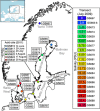Picocyanobacteria containing a novel pigment gene cluster dominate the brackish water Baltic Sea
- PMID: 24621524
- PMCID: PMC4139726
- DOI: 10.1038/ismej.2014.35
Picocyanobacteria containing a novel pigment gene cluster dominate the brackish water Baltic Sea
Abstract
Photoautotrophic picocyanobacteria harvest light via phycobilisomes (PBS) consisting of the pigments phycocyanin (PC) and phycoerythrin (PE), encoded by genes in conserved gene clusters. The presence and arrangement of these gene clusters give picocyanobacteria characteristic light absorption properties and allow the colonization of specific ecological niches. To date, a full understanding of the evolution and distribution of the PBS gene cluster in picocyanobacteria has been hampered by the scarcity of genome sequences from fresh- and brackish water-adapted strains. To remediate this, we analysed genomes assembled from metagenomic samples collected along a natural salinity gradient, and over the course of a growth season, in the Baltic Sea. We found that while PBS gene clusters in picocyanobacteria sampled in marine habitats were highly similar to known references, brackish-adapted genotypes harboured a novel type not seen in previously sequenced genomes. Phylogenetic analyses showed that the novel gene cluster belonged to a clade of uncultivated picocyanobacteria that dominate the brackish Baltic Sea throughout the summer season, but are uncommon in other examined aquatic ecosystems. Further, our data suggest that the PE genes were lost in the ancestor of PC-containing coastal picocyanobacteria and that multiple horizontal gene transfer events have re-introduced PE genes into brackish-adapted strains, including the novel clade discovered here.
Figures





References
-
- Clokie MRJ, Mann NH. Marine cyanophages and light. Environ Microbiol. 2006;8:2074–2082. - PubMed
-
- Doron M, Babin M, Hembise O, Mangin A, Garnesson P. Ocean transparency from space: validation of algorithms estimating Secchi depth using MERIS, MODIS and SeaWiFS data. Remote Sens Environ. 2011;115:2986–3001.
Publication types
MeSH terms
Substances
LinkOut - more resources
Full Text Sources
Other Literature Sources

